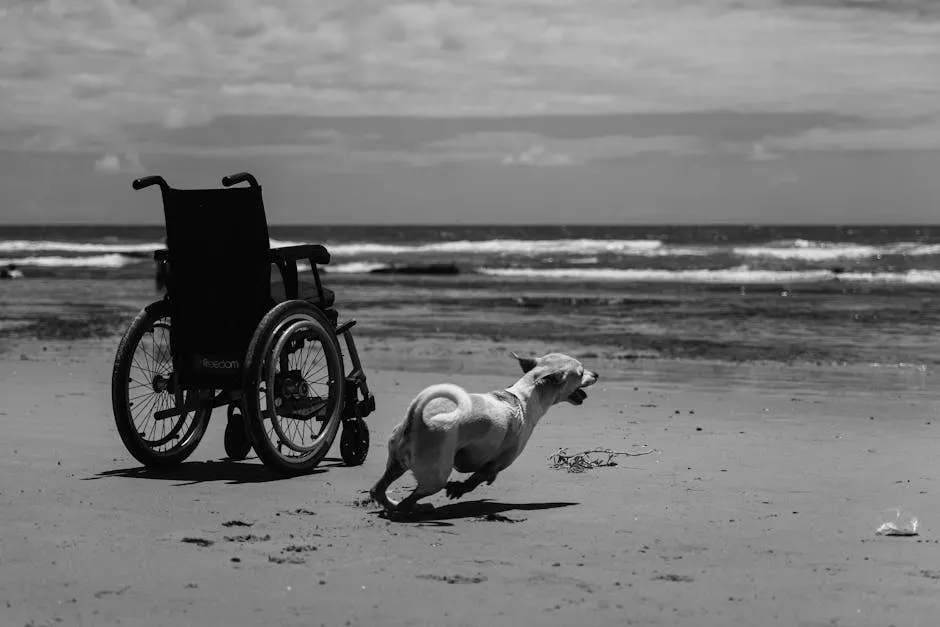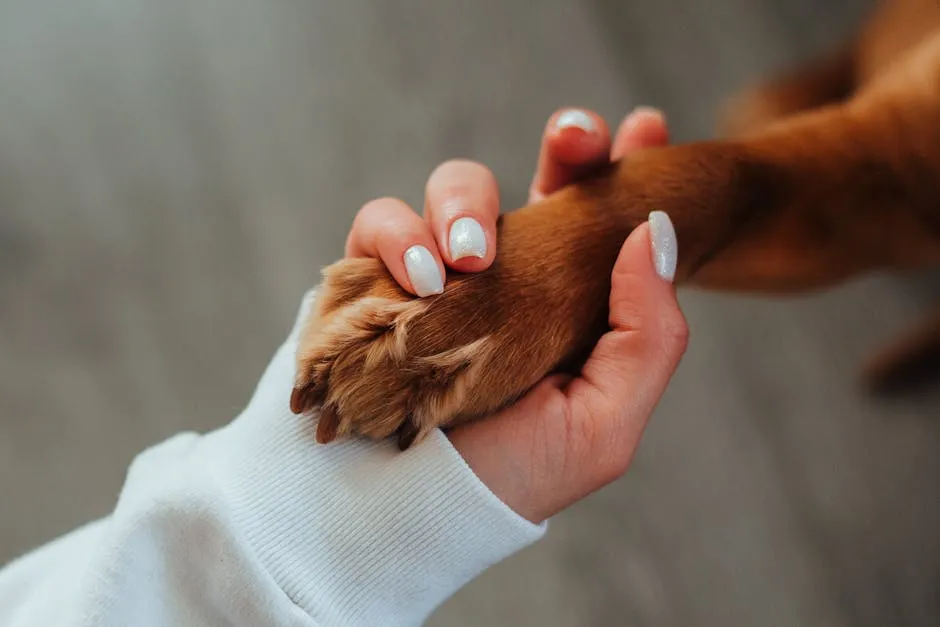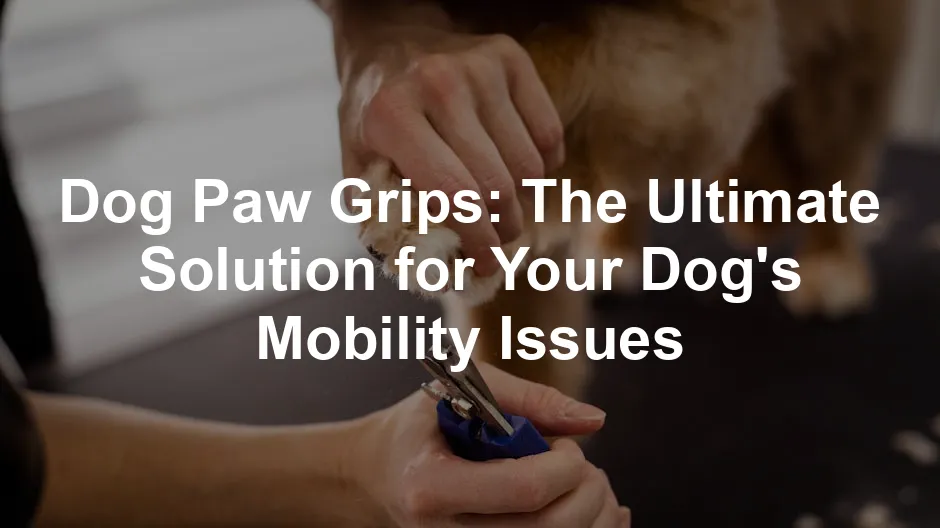Introduction
Have you noticed your furry friend struggling to get around? Dog paw grips are the perfect solution. These handy products enhance mobility, especially for senior dogs or those recovering from injuries. As pet owners become more aware of mobility challenges, the use of paw grips is on the rise. This article will cover the benefits, types, and applications of dog paw grips. We aim to equip you with the knowledge to improve your dog’s quality of life. While we’re at it, let’s not overlook your dog’s grooming needs! A great addition to your pet care toolkit is a Pet Nail Clipper. Keeping those nails trimmed is crucial for your dog’s comfort and mobility, especially with the added traction of paw grips!Summary and Overview
So, what exactly are dog paw grips? They are specially designed grips that attach to your dog’s nails. Their primary function is to add traction on slippery surfaces, making walking easier for your pet. These products are ideal for senior dogs who may be unsteady on their feet. They also benefit dogs recovering from surgery, giving them the support they need to regain their strength. The advantages of using paw grips are significant. They improve mobility, reduce the risk of slipping, and enhance your dog’s overall quality of life. Speaking of enhancing your dog’s life, don’t forget about nutrition! Consider a Dog Joint Supplement to support your furry friend’s joints and keep them active and happy! There are various types of dog paw grips available, including adhesive and non-adhesive options. Each type caters to different needs and preferences. In this article, you’ll find a detailed breakdown of the benefits, types, and how to apply these grips effectively. Let’s help your furry companion regain their confidence and joy in movement!
Benefits of Dog Paw Grips
Improved Traction and Stability
Dog paw grips provide excellent traction on slippery surfaces. They help your pet feel secure while walking on hardwood floors or tiles. If your dog struggles to maintain balance, paw grips can be a game changer. Statistics show that 20% of pets experience mobility issues as they age. This can lead to slips and falls, causing injury. With paw grips, your dog can walk confidently without fear of sliding. Many pet owners report a noticeable difference in their dog’s stability after using these grips. Now, if your dog enjoys a little adventure, you might also want to consider a Dog Ramp for Cars. It provides a safe way for your pooch to hop in and out of your vehicle without straining their joints!Enhanced Quality of Life for Senior Dogs
Paw grips significantly improve the quality of life for senior dogs. They allow older pets to regain confidence and independence. Imagine your furry friend being able to stroll around the house without fear of slipping! Testimonials highlight how these grips have transformed lives. One owner shared that her elderly dog, who once hesitated to walk, now moves around freely. The emotional impact is profound; seeing your pet regain joy in movement is priceless. Paw grips not only aid mobility but also provide emotional support. They allow senior dogs to feel secure and engaged in daily activities. This contributes to their overall happiness and well-being. You can read more about this in our Guide to choosing the right dog food for senior dogs. And while we’re discussing their well-being, a cozy Dog Bed for Senior Dogs is essential for providing them comfort while they rest and rejuvenate after a day of adventures!
Recovery Aid for Injured Dogs
Are you worried about your dog recovering from surgery? Dog paw grips can be a fantastic aid during their healing process. These grips help injured dogs regain their strength and mobility. They can provide much-needed traction on slippery surfaces, making every step safer. Specific conditions like hip dysplasia and arthritis can significantly benefit from using paw grips. Dogs with hip dysplasia often struggle to maintain stability. You can learn more about this condition in our Understanding and managing canine hip dysplasia article. If you’re looking to actively support your dog’s joint health, don’t forget about a Dog Treats for Joint Health. They’re a tasty way to ensure your pup gets the nutrients they need for a happy, active life! Similarly, arthritis can make walking painful. With grips, your furry friend can navigate without as much discomfort. You can also find helpful information on managing arthritis in our Best supplements for dogs with joint pain and arthritis article. Veterinarians often recommend these products. They have seen firsthand how effective paw grips are for recovery. One case involves a dog recovering from a knee surgery. After using paw grips, the dog showed remarkable improvement. The owner reported increased confidence during walks. This positive change can make a world of difference in a dog’s recovery journey. By providing stability, paw grips help injured dogs feel secure. They boost confidence and encourage movement, which is essential for healing. If your dog is recovering from surgery or an injury, consider trying paw grips. Your furry companion may thank you for it!
Custom-fit vs. One-Size-Fits-All
When it comes to dog paw grips, choosing the right fit is crucial. Custom-fit grips are tailored specifically for your dog’s paws. They provide a snug fit, enhancing traction and comfort. On the other hand, one-size-fits-all options aim to cater to various breeds and sizes. While these options offer convenience, they may not provide the same level of effectiveness. A proper fit ensures that the grips stay in place during movement. If they are too loose, they can slip off or cause discomfort. Conversely, if they are too tight, they may restrict movement or cause pain. For maximum effectiveness, consider your dog’s unique paw shape. Measuring your dog’s paws can help you find the perfect fit. Investing in custom-fit grips can lead to better results, improving your dog’s mobility and confidence.
How to Apply Dog Paw Grips
Step-by-Step Application Guide
Applying dog paw grips is easy with the right technique. Follow these steps for a secure fit: 1. **Prepare the Paws**: Start by cleaning your dog’s paws. Make sure they are dry and free from dirt or oil.2. **Measure the Grips**: Cut the grips to the appropriate length according to your dog’s nails.
3. **Position the Grip**: Place the grip at the base of the nail. Ensure it wraps around snugly without pinching.
4. **Secure the Grip**: Gently wrap the grip around the nail, pressing firmly to ensure it sticks to itself.
5. **Check for Comfort**: Observe your dog as they walk. Make sure they can move comfortably without any signs of distress. For a secure fit, consider applying grips on all four paws. This helps maintain balance and stability.
Common Mistakes to Avoid
Many pet owners make mistakes during application. Here are some common errors and how to fix them: – **Skipping the Cleaning Step**: Not cleaning the paws can cause grips to slip. Always start with clean, dry paws.– **Incorrect Sizing**: Using grips that are too long or short can lead to discomfort. Measure your dog’s nails carefully before cutting.
– **Poor Application Technique**: Wrapping the grips too loosely can result in slippage. Ensure a snug, secure fit without pinching. If issues arise, revisit the application process. With practice, you’ll become more adept at using paw grips effectively. Your dog will appreciate the added comfort and stability!

Maintenance and Care
How Long Do Paw Grips Last?
The lifespan of dog paw grips varies. Most last between 2 to 4 weeks. This timeframe can be affected by several factors. For instance, the activity level of your dog plays a significant role. Active dogs may wear through grips faster. The type of grip also matters. Silicone grips generally offer better durability than adhesive options. To maximize longevity, consider these tips: – **Regular Checks**: Inspect grips weekly for wear and tear.– **Limit Exposure**: Remove grips during rough play or outdoor adventures.
– **Proper Fit**: Ensure grips are snug but not too tight, preventing unnecessary stress. By following these steps, you can extend the lifespan of your dog’s paw grips. And while you’re at it, a Dog First Aid Kit is a must-have for any pet owner. You never know when your furry friend might need a little extra care!

Cleaning and Reapplication
Cleaning your dog’s paws is crucial for maintaining paw grips. Start by gently washing their paws with mild soap and water. Rinse thoroughly and dry completely. This removes dirt and oils that can affect grip adhesion. Before reapplying the grips, ensure the nails are clean. If you notice any residue, you can wipe them down with isopropyl alcohol. This helps improve grip adhesion. As for reapplication frequency, it largely depends on usage. For dogs with moderate activity, reapply every 2-3 weeks. If your dog is more active, consider weekly checks to see if they need replacement.Customer Experiences and Testimonials
Real-Life Success Stories
Many pet owners have shared their experiences with dog paw grips. One owner reported how her senior dog regained mobility after using grips. The dog, once hesitant to walk, now moves confidently around the house. Another testimonial highlighted a dog recovering from surgery. After using paw grips, the dog’s confidence improved significantly. The owner noted that their furry friend could navigate stairs much better. These success stories show the positive impact that paw grips can have on mobility and quality of life for pets.
Challenges and Limitations
While many dogs benefit from paw grips, some face challenges. A few owners have reported difficulties in application. If grips are not properly fitted, they may not provide the desired traction. Additionally, some dogs may take time to adjust. If the grips seem ineffective, consider trying a different type. Consulting with your veterinarian can also provide insights into your dog’s specific needs. Acknowledging these limitations is important. It ensures you choose the right solution for your furry friend.
Conclusion
In summary, dog paw grips can significantly enhance mobility for dogs. With proper maintenance and care, you can maximize their effectiveness. Many pet owners report improved quality of life for their furry companions. If your dog struggles with mobility, consider trying paw grips. They could make a world of difference in your dog’s daily activities. Also, consider investing in a Dog Carrier Backpack for those long walks or hikes, making it easier to take them along!
FAQs
What are dog paw grips, and how do they work?
Dog paw grips are traction-enhancing products for dogs. They help improve mobility on slippery surfaces.
Are there any side effects of using paw grips on dogs?
Generally, paw grips are safe. However, monitor for discomfort or irritation.
How do I know if my dog needs paw grips?
Look for signs like slipping on floors or reluctance to walk.
How to choose the right type of paw grips for my dog?
Consider your dog’s size, activity level, and specific mobility needs.
Can paw grips be used for dogs with specific health conditions?
Yes, they can help dogs with arthritis, hip dysplasia, or other mobility issues.
All images from Pexels





